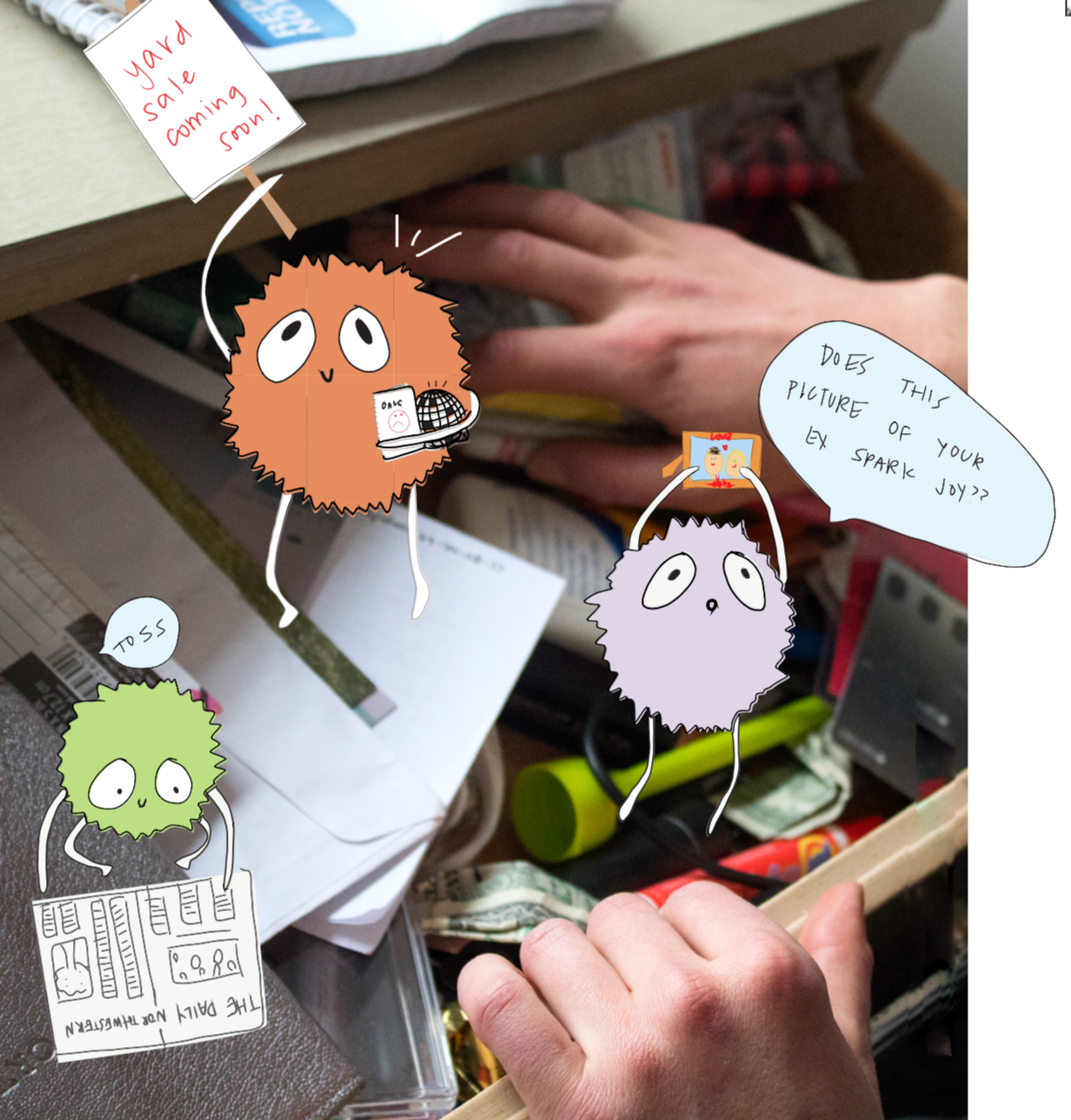Keep: 10-pound disco ball. Toss: 10th edition textbook.
Illustrations by Sarah Zhang
At the end of winter break, I was trying to fit all my clothes around a 10-pound disco ball in my suitcase. When I texted a friend in exasperation to complain that I had too much stuff. “Do the Marie Kondo folding method,” she advised sagely. Having no idea what she meant, I googled it.
 It’s early winter quarter, my classes are harder than I’d anticipated, and I’m feeling desperately behind in my job search. As usual, my room is horrifically messy. Piles of clothes on the floor, Tupperware and mugs on my dresser, desk unusable. (I’ve never met someone in college with a messier room than mine.)
It’s early winter quarter, my classes are harder than I’d anticipated, and I’m feeling desperately behind in my job search. As usual, my room is horrifically messy. Piles of clothes on the floor, Tupperware and mugs on my dresser, desk unusable. (I’ve never met someone in college with a messier room than mine.)
When NBN needed a writer to try out Marie Kondo’s decluttering method, I pounced. Here was the accountability I needed to do something I’d never managed to do before: clean my room and keep it that way. And with other aspects of my life feeling out of my control, this was tangible way to get some back.
Eventually I got off the waitlist for her book, The Life-Changing Magic of Tidying Up, and quickly devoured it. My take: skip the show, read the book. It is honestly inspiring and filled with wisdom, such as “treat your socks with respect” and “if you are a woman, try wearing something elegant as nightwear.” The overarching principle of Kondo’s method is simple: keep your possessions that spark joy and get rid of everything else. This process is broken up into five steps: clothes first, then books, paper, komono (miscellany), and finally sentimental items. Upon finishing the book I felt prepared to tackle my space.
Not surprisingly, I had way too many clothes. All the stuff I inexplicably bought from the GAP freshman year? Not joy-sparking. Neither were the dozen distinct Northwestern shirts I managed to hang on to, or the matching purple hat, gloves and scarf my grandmother got me as a gift to wear to tailgates, or the jeans that fit me fall quarter freshman year and haven’t since. To Kondo’s detriment, I did keep my tattered pajamas despite her admonition that “the worst think you can do is to wear a sloppy sweatsuit.”
Books were an easy category. The first one to go was Gary Saul Morson’s Hidden in Plain Sight: Narrative and Creative Potentials in ‘War and Peace.’ I got a C in Slavic Studies 310 because I skipped most classes to hammock on the Lakefill, and I don’t regret it. But I also don’t need to be reminded every time I look at my bookshelf. I kind of cheated by piling up the rest of my old textbooks and sticking them under my bed, but I figure I’ll have to deal with them by graduation.
Tackling paper consisted of recycling the notebooks that I would realistically have never opened again. This included my AP Stats notes from high school that I thought might be helpful as a statistics major in college. (They weren’t.)
Finally, I approached my sentimental belongings – photos, cards, gifts, and souvenirs I’ve acquired over the past three and a half years. As an emotionally unstable senior this was a taxing experience, but in a good way. I finally bought a photo album and debated throwing away the picture of me and my high school boyfriend at graduation. I really don’t like him anymore but decided it needed to stay for the historical record.
In the end, I actually think Marie Kondo enabled me to be my sloppy self, but in a more tolerable way. I will miss my big biweekly cleaning sessions as a procrastination tool, but I am grateful that the path from my bed to my dresser is no longer become impassable.
As for the disco ball, it survived the flight from California and now hangs in the entryway to my room. If anyone out there also happens to find a disco ball in their parents’ storage unit, I would not advise attempting to bring it to campus. Instead I would recommend looking out for mine on Free & For Sale in June.